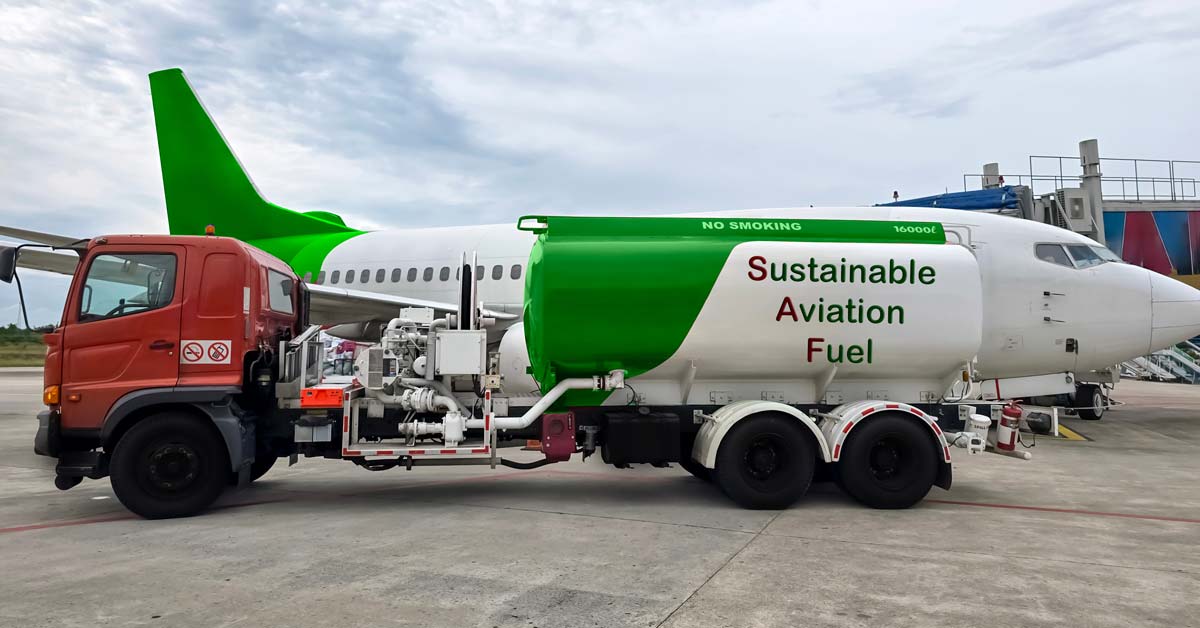5 min read
How Feedstocks from Crops Create Advanced Biofuels
ResourceWise
:
Jun 13, 2025 9:00:00 AM

As the world pushes toward a greener future, one very important concern is waste reduction. Waste reduction aims to reduce landfill volume, promote sustainable practices, and create a healthier planet.
In the spirit of this objective, one area of increased attention is advanced biofuels, which turn waste into valuable energy sources. This post will explore what advanced biofuels are, how they're made, and their benefits. We'll spotlight two types of advanced biofuels made from residual non-food parts of food crops and non-food crops.
A Quick Refresher on Biofuels
What are First-Generation Biofuels?
First-generation biofuels are produced from food crops like corn, sugarcane, and soybeans. While they can be relatively easy to produce, they come with significant drawbacks.
- Competition for Space: These biofuels compete with food supplies, displacing crops that could be used for human consumption.
- Large Resource Draw: The feedstocks used in first-gen biofuels require large amounts of land, water, and energy to cultivate and process. This can contribute to soil degradation, water scarcity, and higher greenhouse gas emissions than their renewable promise suggests.
What are Second-Generation Biofuels?
Second-generation biofuels, also called advanced biofuels, present a more sustainable alternative to first-generation options. Advanced biofuels are produced from non-food biomass.
Examples of second-generation biofuels' feedstocks include:
- Agricultural Residues: Leftover elements from food crop harvests that are not edible or used as food in any way.
- Forestry Waste: Woody biomass, waste products from forestry, and pulp and paper residues such as crude tall oil.
- Dedicated Energy Crops: Crops grown specifically for energy use, typically on land unusable for food crops.
These distinctions are crucial because advanced biofuels utilize waste materials destined for landfills. These feedstocks can help alleviate stress on food supply chains and agricultural resources.
By shifting the focus from food to waste, these biofuels maintain an eco-friendlier profile and enhance their overall sustainability.
Second Generation Biofuels Market Update
The advanced biofuels sector is experiencing significant growth, driven by technological advancements, supportive policies, and increasing demand for sustainable energy solutions.
Market Growth and Projections
The second generation biofuels market is projected to reach approximately $33.23 billion by 2029, growing at a compound annual growth rate (CAGR) of 25.3%. This growth is fueled by the rising demand for cleaner energy sources and the environmental benefits associated with biofuels. Advanced biofuels, including cellulosic ethanol, biodiesel, and bio-butanol, are gaining traction due to their potential to reduce greenhouse gas emissions and reliance on fossil fuels.
Technological Advancements and Collaborations
Innovations in biofuel production technologies are playing a crucial role in the sector's expansion. Strategic partnerships are emerging as key drivers of growth. For instance, Shell's agreement with Raízen to purchase 3.25 billion liters of cellulosic ethanol made from sugarcane exemplifies such collaborations aimed at scaling up production and distribution.
Policy Support and Regulatory Frameworks
Government policies are significantly influencing the adoption of advanced biofuels. The European Union, for example, has implemented subsidies to encourage airline adoption of sustainable aviation fuels (SAF). They are offering financial support for over 200 million liters of SAF purchases.
These subsidies aim to bridge the cost gap between SAF and traditional kerosene. The move will help to promote cleaner alternatives in the aviation sector.
Challenges and Regional Disparities
Despite the positive outlook, the sector faces challenges with high production costs and policy uncertainties.
In North America, biofuel companies are reducing production due to unclear policies on green fuel subsidies and fears of trade conflicts. These factors have all come together to adversely impact the industry's growth.
Moreover, the UK's biodiesel sector is also under pressure from subsidized American imports. The result is potential plant closures and calls for government intervention.
Realizing advanced biofuel's full potential will not come easily. It will require addressing existing challenges through technological innovation, strategic partnerships, and supportive policy frameworks.
Food Crops: From Waste to Benefit
Using Residual Non-Food Elements
Food crops include various non-food parts, such as stems, husks, and leaves, often discarded as waste. These residual elements can be transformed into biofuels, maximizing the utility of every part of the plant while significantly reducing waste.
Converting these seemingly useless by-products into feedstocks provides farmers an immediate secondary revenue stream. Even better, it supports a more circular agricultural system, promoting sustainability in food production.
Preventing Land Use Change
Another advantage of utilizing non-food parts of food crops for biofuel production is preventing land use change. Land use change refers to converting agricultural farmland into biofuel feedstock crops.
These changes can further strain an already challenging food climate. Potentially reducing available land for food crops worsens the hunger crisis in many growing regions.
Advanced biofuels can mitigate these risks using resources from existing agricultural lands without diverting resources away from essential food production.
By managing land effectively, we can protect valuable ecosystems and help maintain biodiversity. This conservation strategy is fundamental to achieving long-term sustainability and resilience within our food systems.
Types of Fuels Produced from Food Crop Wastes
Advanced biofuels sourced from food crop residues can produce a range of fuels:
- Ethanol: Ethanol, used primarily as a fuel additive, works to reduce carbon emissions when blended with traditional gas.
- Biodiesel: Biodiesel can serve as a direct substitute for traditional diesel in many vehicles.
- Biogas: Biogas, created through anaerobic digestion, provides renewable energy for heating and electricity generation.
Collectively, these fuel types offer a cleaner, more sustainable alternative to conventional fossil fuels while enhancing energy security.
Non-Food Crops and Advanced Biofuels
Dedicated Energy Crops
Non-food crops—such as switchgrass, miscanthus, and jatropha—are cultivated specifically for biofuel production rather than human food consumption. These crops are often planted on marginal lands unsuitable for agricultural use. Accordingly, they do not compete with traditional farming practices.
Benefits of Non-Food Crops
Non-food crops have numerous advantages that make them a beneficial feedstock for biofuel production. They are typically hardy, require minimal fertilizers and pesticides, and can flourish in poor soil conditions.
These benefits also mean reduced overall production costs and a decreased carbon footprint compared to food crops. Additionally, cultivating non-food crops can bolster local economies by providing new agricultural opportunities.
Types of Fuels Produced from Non-Food Crops
The conversion of non-food crops can yield various advanced biofuels, including the following:
- Cellulosic Ethanol: Cellulosic ethanol comprises fibrous plant parts and can significantly reduce lifecycle greenhouse gas emissions.
- Biodiesel: This fuel directly replaces traditional diesel, simplifying the biofuel swap.
- Sustainable Aviation Fuel: Renewable jet fuel, or sustainable aviation fuel (SAF), offers an eco-friendly alternative for airlines, a major contributor to global carbon emissions.
Each fuel type offers cleaner energy alternatives while aiding in the green transition within the carbon-heavy transportation sector.
The Future of the Second-Generation Biofuels Market
Moving Toward a Circular Economy
Advanced biofuels are essential in the transition toward a circular economy—a system characterized by reduced waste, efficient resource use, and sustainable processes.
Second-generation biofuels can help foster sustainable development while significantly lessening environmental impacts. This shift in perspective emphasizes the importance of waste as a potential resource rather than merely a disposal challenge.
Potential for Growth in the Second-Generation Biofuel Market
The advanced biofuels market is poised for substantial growth in the coming years.
Technological innovations continue to advance alongside increasing investment in fuel research and development. Looking forward, the production and adoption of these fuels are expected to flourish.
Governments and private firms alike are recognizing the potential benefits of advanced biofuels. Over time, this will lead to greater incentives and support for sustainable energy initiatives that can foster economic growth and job creation.
The Path Forward for Biofuels
Advanced biofuels represent a crucial step forward in our collective pursuit of sustainability. They help reduce waste, lower greenhouse gas emissions, and support a circular economy. By turning waste into a resource, advanced biofuels can contribute significantly to achieving our collective climate goals.
Make sure to subscribe to our blog and monthly newsletter to receive critical updates on news and announcements across the biofuels sector.
(This post was originally published in September 2024 and was updated in June 2025 for accuracy and relevance.)




